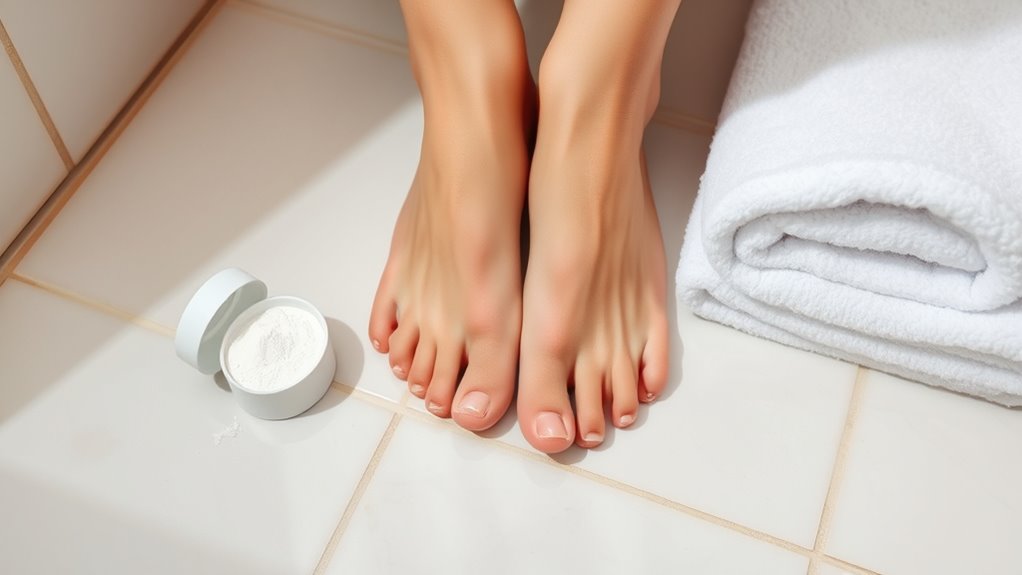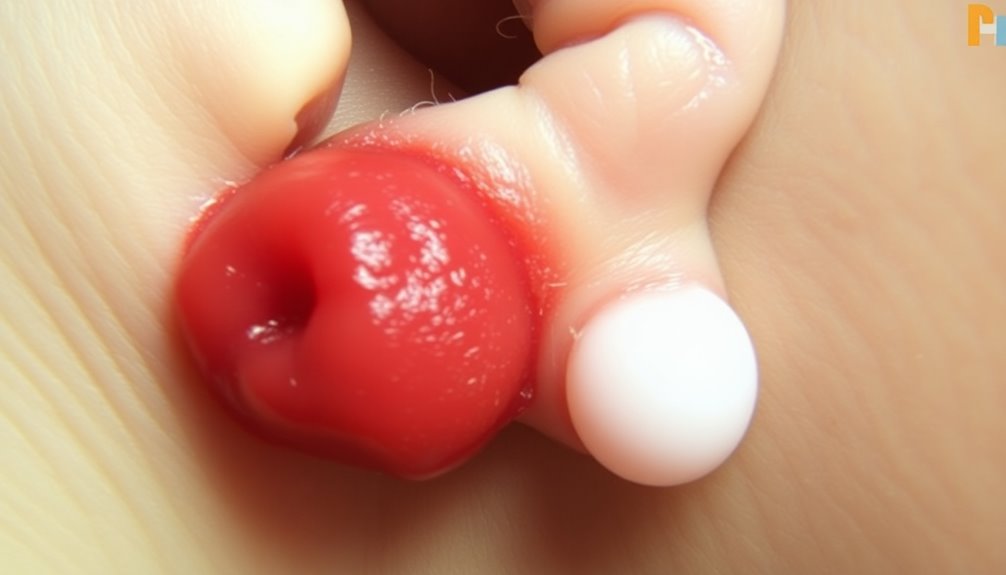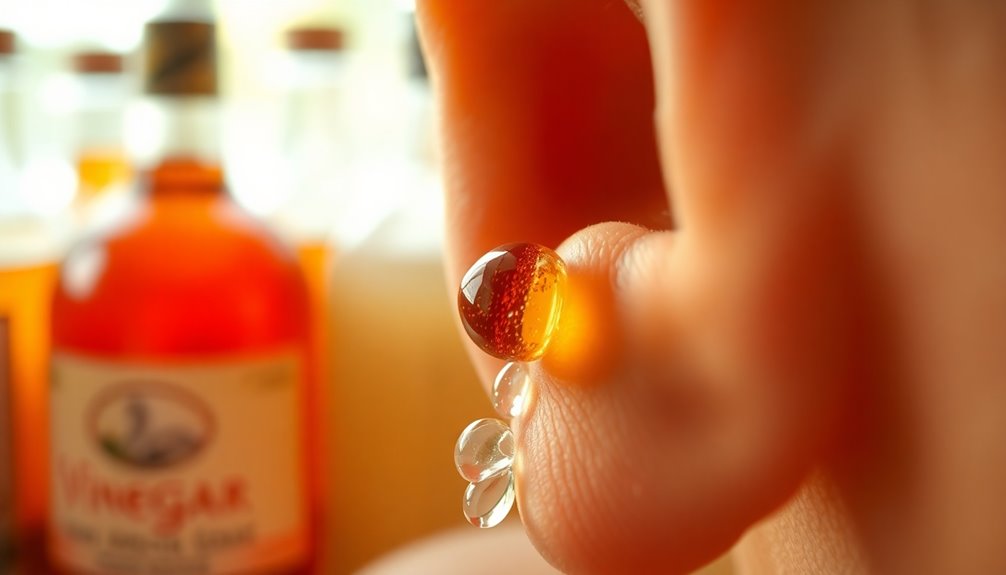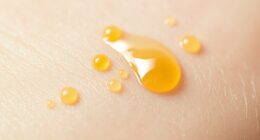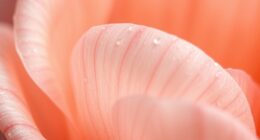To prevent athlete’s foot, you should keep your feet dry and well-ventilated by changing socks daily and choosing breathable shoes made from mesh or leather. Practice good hygiene by washing and thoroughly drying your feet, especially between toes. Use antifungal powders or sprays regularly, and always wear protective footwear in communal areas like showers and pools. Staying consistent with these habits can keep fungi at bay—continue with these tips to learn more about effective prevention.
Key Takeaways
- Keep feet dry and well-ventilated by thoroughly drying after showering and using moisture-wicking socks.
- Wear breathable footwear made from mesh or leather and avoid plastic or rubber shoes.
- Apply antifungal powders or sprays regularly to prevent fungal growth and follow treatment schedules diligently.
- Always wear protective footwear like flip-flops in communal areas such as gyms and swimming pools.
- Practice good foot hygiene daily by washing thoroughly, changing socks regularly, and avoiding sharing shoes or towels.
Keep Feet Dry and Well-ventilated
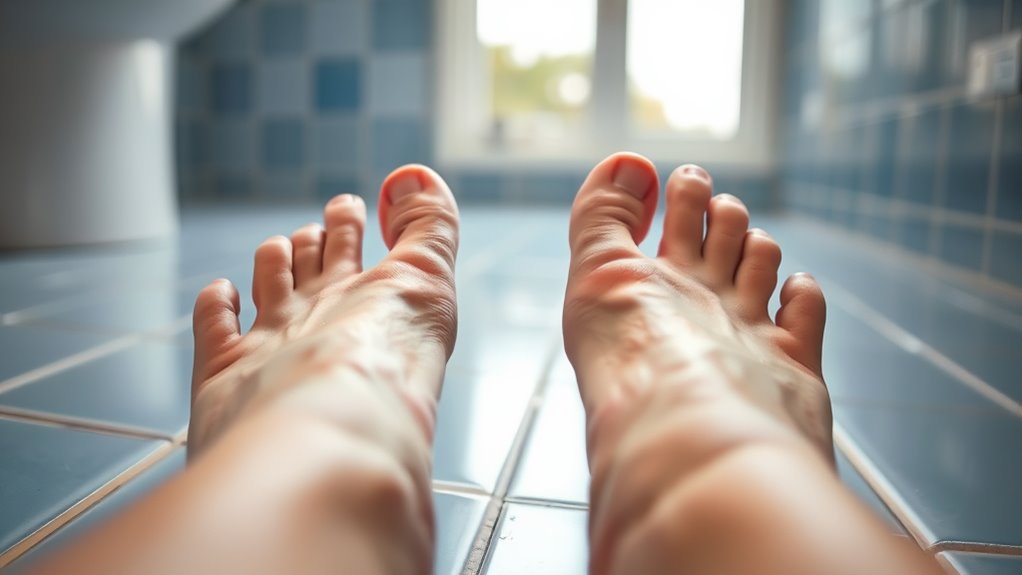
Keeping your feet dry and well-ventilated is essential in preventing athlete’s foot. Moisture creates the perfect environment for fungi to thrive, so it’s vital to keep your feet as dry as possible. After showering or sweating, make sure to thoroughly dry between your toes and all around your feet. Wearing shoes that allow airflow helps reduce moisture buildup, so avoid tight, non-breathable footwear. Consider taking off your shoes periodically during the day to let your feet breathe. Using foot powders or antiperspirants designed for feet can also help control moisture. Additionally, proper footwear material plays a significant role in moisture management. By maintaining dryness and good airflow, you considerably lower your risk of developing athlete’s foot and keep your feet healthy and comfortable.
Choose Breathable Footwear and Socks

Choosing footwear and socks made from breathable materials helps keep your feet dry and comfortable. These options allow moisture to escape, reducing the risk of athlete’s foot. Prioritizing moisture control is key to maintaining healthy, fungus-free feet. Additionally, selecting AI-powered diagnostic tools can help monitor foot health more effectively.
Moisture Control for Feet
To effectively prevent athlete’s foot, it’s essential to manage moisture around your feet. Choosing the right footwear and socks helps keep your feet dry and reduces fungal growth. Opt for shoes made of breathable materials like mesh or leather, which allow moisture to escape. Avoid tight shoes that trap sweat and heat. Select moisture-wicking socks that draw sweat away from your skin, and change them daily if you sweat heavily. Proper moisture control creates an environment less hospitable to fungi. Here’s a quick guide:
| Footwear Material | Sock Type | Moisture Management |
|---|---|---|
| Mesh or Leather | Moisture-wicking | Keeps feet dry |
| Synthetic | Cotton | Absorbs sweat |
| Breathable | Athletic socks | Reduces fungal risk |
| Tight-fitting | No-shows | Traps moisture |
Additionally, ensuring proper foot hygiene by washing and thoroughly drying your feet can further reduce the risk of athlete’s foot.
Selecting Breathable Materials
Selecting breathable footwear and socks plays an essential role in maintaining dry feet and preventing athlete’s foot. Choose shoes made from materials like mesh or leather that allow air to circulate and wick away moisture. Avoid plastic or rubber shoes, which trap heat and sweat. When it comes to socks, opt for those made from natural fibers such as cotton or moisture-wicking synthetics like polyester. These materials help keep your feet dry by drawing sweat away from your skin. Change your socks daily, especially after sweating or intense activity. Properly fitting shoes also prevent friction and blisters, reducing entry points for fungi. Incorporating natural materials into your footwear and socks can enhance breathability and further discourage fungal growth. By choosing breathable materials, you create an environment that discourages fungal growth and keeps your feet healthier.
Practice Good Foot Hygiene Daily

Practicing good foot hygiene daily is essential in preventing athlete’s foot. You should wash your feet thoroughly with soap and water every day, paying attention to the spaces between your toes. Dry your feet completely, especially between your toes, to eliminate moisture that fungi thrive on. Keep your feet clean and dry to reduce fungal growth and infection risk. Incorporating hygiene practices can further enhance your foot health and prevent fungal infections.
Change Socks and Shoes Regularly

Changing your socks and shoes regularly is essential for preventing athlete’s foot. Wearing the same pair day after day allows moisture and fungi to build up, creating an ideal environment for infection. Make it a habit to swap out your socks at least once daily, especially if your feet sweat heavily. Choose breathable, moisture-wicking socks to keep your feet dry longer. Regarding shoes, rotate pairs to give each one time to air out and dry completely between uses. Avoid wearing damp or sweaty shoes for extended periods, as this promotes fungal growth. Properly drying your shoes and opting for well-ventilated options can considerably reduce the risk of athlete’s foot. Consistent shoe and sock changes are simple steps that make a big difference in foot health. Additionally, using anti-fungal powders or sprays inside your shoes can help prevent fungal buildup and keep your feet healthier.
Use Antifungal Powders or Sprays

Applying antifungal powders or sprays correctly guarantees you get the best protection against athlete’s foot. Choose a product suited for your needs and follow the instructions for proper application. Remember to reapply regularly to keep your feet dry and fungus-free.
Proper Application Techniques
To effectively prevent athlete’s foot, proper use of antifungal powders or sprays is essential. First, verify your feet are clean and dry before application, as moisture encourages fungal growth. If using powder, sprinkle it evenly over your toes, soles, and between your toes, gently patting to distribute. For sprays, hold the can about six inches from your feet and spray thoroughly, covering all affected areas. Avoid over-application, which can cause buildup or discomfort. Reapply as directed, usually once or twice daily, especially after bathing or sweating. Make sure to reach all areas of your feet, including hard-to-see spots. Consistent and correct application helps the medication work effectively, reducing the risk of infection returning. Proper technique is key to keeping athlete’s foot at bay. Incorporating data privacy considerations into your routine can also help protect your personal health information when managing treatment.
Choosing the Right Product
What’s the best antifungal product for preventing athlete’s foot? The key is choosing between powders or sprays that contain proven antifungal ingredients like terbinafine or clotrimazole. Powders are great for keeping your feet dry and absorbing sweat, which discourages fungal growth. Sprays offer quick, even coverage and are convenient for on-the-go use. When selecting a product, look for those labeled specifically for athlete’s foot and follow the instructions carefully. Consider your activity level and personal preferences—if you sweat heavily or have difficulty applying powders, a spray might be easier. Always choose a product that suits your skin type and is formulated for foot use. Properly selecting the right antifungal product helps you stay ahead of fungal infections effectively. Additionally, using dog beds for Golden Retrievers can help keep your environment clean and reduce fungal contamination.
Regular Reapplication Schedule
Maintaining a consistent reapplication schedule is essential for effective athlete’s foot prevention when using antifungal powders or sprays. Regularly applying your treatment keeps fungi at bay and prevents infection from spreading. Set a routine, such as every morning and after workouts, to stay vigilant. Skipping doses can allow the fungus to thrive and worsen your condition. To help you stay motivated, here’s a reminder of what’s at stake:
| Confidence | Comfort | Healing |
|---|---|---|
| Stay protected | Feet stay dry | Faster recovery |
| Prevent setbacks | No more itching | Confidence restored |
| Keep moving | Stay comfortable | Feel strong again |
Stick to your schedule, and you’ll keep athlete’s foot under control and regain your foot health. Consistent application is crucial because fungal growth can accelerate quickly if treatments are inconsistent.
Take Precautions in Communal Areas
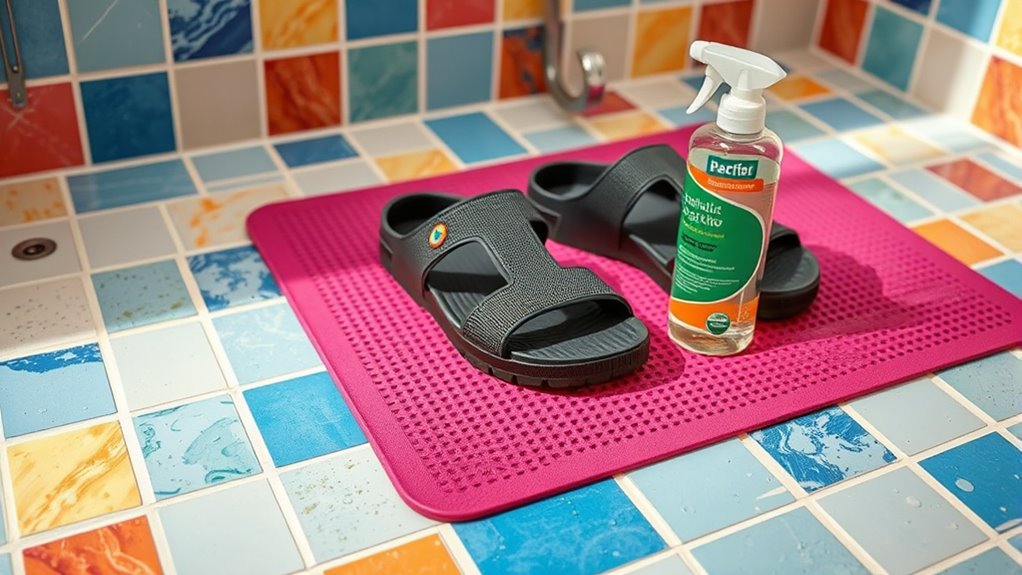
When you visit communal areas like gyms, locker rooms, or swimming pools, taking simple precautions can considerably reduce your risk of athlete’s foot. Always wear flip-flops or water shoes instead of walking barefoot, as fungi thrive in damp, shared spaces. Make sure to dry your feet thoroughly, especially between your toes, before putting on socks or shoes. Use a clean towel or disposable wipes to dry your feet after showering. Avoid sharing towels, shoes, or socks with others. If possible, choose well-ventilated shoes made of breathable materials, and change your socks daily. Proper footwear ventilation also plays a crucial role in preventing fungal infections. By practicing these habits, you create a less hospitable environment for fungi and greatly lower your chances of developing athlete’s foot in communal areas.
Frequently Asked Questions
Can Athlete’S Foot Be Inherited From Family Members?
You might wonder if athlete’s foot runs in your family. While it’s not directly inherited, your family members can pass on the fungi that cause it. If someone in your household has athlete’s foot, you’re more likely to catch it, especially if you share shoes, socks, or shower areas. Good hygiene and avoiding contaminated items help prevent infection, regardless of family history.
Are There Specific Foods That Help Prevent Athlete’S Foot?
Figuring out foods that fend off fungal foes can be fantastic. You should focus on foods rich in probiotics, like yogurt and fermented foods, which boost your body’s defenses. Incorporate garlic for its antifungal properties, and add leafy greens for their immune-boosting benefits. Staying hydrated and maintaining good hygiene are also key. By balancing your diet with these beneficial foods, you can help prevent fungal infections like athlete’s foot effectively.
How Long Does It Typically Take to Recover From Athlete’S Foot?
Recovery time varies depending on the severity of the infection and your treatment. Typically, it takes about 2 to 4 weeks with proper antifungal medication. You should keep your feet clean and dry, change socks regularly, and follow your healthcare provider’s instructions carefully. If you don’t see improvement after a few weeks or if symptoms worsen, consult your doctor. Consistency and good hygiene are key to speeding up recovery.
Can Athlete’S Foot Spread to Other Parts of the Body?
Yes, athlete’s foot can spread to other parts of your body, especially if you scratch or touch the infected area and then contact other skin. You might develop conditions like jock itch or ringworm. To prevent this, avoid scratching, wash your hands often, and keep affected areas clean and dry. Using antifungal treatments promptly helps stop the spread and speeds up recovery, protecting your overall skin health.
Is It Safe to Use Home Remedies Instead of Medication?
Did you know that around 70% of people with athlete’s foot try home remedies first? You might think it’s safe to skip medication, but it’s risky. Home remedies can help, but they often aren’t enough to fully clear the infection. If symptoms persist or worsen, you should see a healthcare professional. Using proven antifungal treatments guarantees faster relief and reduces the chance of spreading or worsening the infection.
Conclusion
By keeping your feet dry and well-ventilated, you create a fortress against athlete’s foot. Think of your shoes as shields and your socks as armor—when you choose breathable options and change them often, you build a strong defense. Practice good hygiene daily and use antifungal powders like secret weapons. In communal areas, imagine yourself as a cautious explorer, taking steps to avoid hidden traps. With these habits, you’ll keep athlete’s foot at bay, standing tall and confident.
